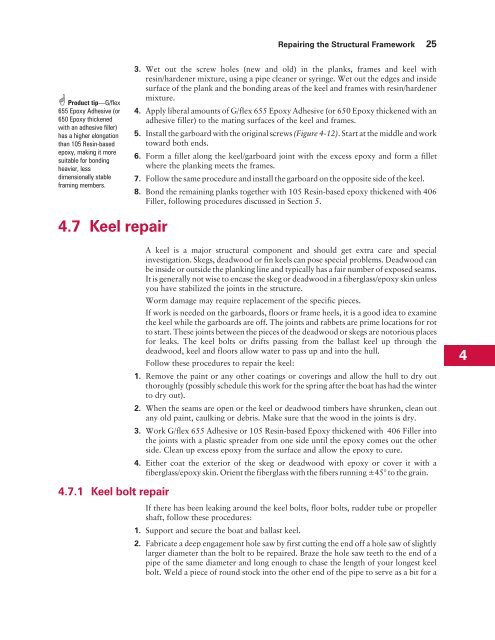Wooden Boat Restoration Repair - WEST SYSTEM Epoxy
Wooden Boat Restoration Repair - WEST SYSTEM Epoxy
Wooden Boat Restoration Repair - WEST SYSTEM Epoxy
Create successful ePaper yourself
Turn your PDF publications into a flip-book with our unique Google optimized e-Paper software.
Product tip—G/flex<br />
655 <strong>Epoxy</strong> Adhesive (or<br />
650 <strong>Epoxy</strong> thickened<br />
with an adhesive filler)<br />
has a higher elongation<br />
than 105 Resin-based<br />
epoxy, making it more<br />
suitable for bonding<br />
heavier, less<br />
dimensionally stable<br />
framing members.<br />
4.7 Keel repair<br />
4.7.1 Keel bolt repair<br />
<strong>Repair</strong>ing the Structural Framework 25<br />
3. Wet out the screw holes (new and old) in the planks, frames and keel with<br />
resin/hardener mixture, using a pipe cleaner or syringe. Wet out the edges and inside<br />
surface of the plank and the bonding areas of the keel and frames with resin/hardener<br />
mixture.<br />
4. Apply liberal amounts of G/flex 655 <strong>Epoxy</strong> Adhesive (or 650 <strong>Epoxy</strong> thickened with an<br />
adhesive filler) to the mating surfaces of the keel and frames.<br />
5. Install the garboard with the original screws (Figure 4-12). Start at the middle and work<br />
toward both ends.<br />
6. Form a fillet along the keel/garboard joint with the excess epoxy and form a fillet<br />
where the planking meets the frames.<br />
7. Follow the same procedure and install the garboard on the opposite side of the keel.<br />
8. Bond the remaining planks together with 105 Resin-based epoxy thickened with 406<br />
Filler, following procedures discussed in Section 5.<br />
A keel is a major structural component and should get extra care and special<br />
investigation. Skegs, deadwood or fin keels can pose special problems. Deadwood can<br />
be inside or outside the planking line and typically has a fair number of exposed seams.<br />
It is generally not wise to encase the skeg or deadwood in a fiberglass/epoxy skin unless<br />
you have stabilized the joints in the structure.<br />
Worm damage may require replacement of the specific pieces.<br />
If work is needed on the garboards, floors or frame heels, it is a good idea to examine<br />
the keel while the garboards are off. The joints and rabbets are prime locations for rot<br />
to start. These joints between the pieces of the deadwood or skegs are notorious places<br />
for leaks. The keel bolts or drifts passing from the ballast keel up through the<br />
deadwood, keel and floors allow water to pass up and into the hull.<br />
Follow these procedures to repair the keel:<br />
1. Remove the paint or any other coatings or coverings and allow the hull to dry out<br />
thoroughly (possibly schedule this work for the spring after the boat has had the winter<br />
to dry out).<br />
2. When the seams are open or the keel or deadwood timbers have shrunken, clean out<br />
any old paint, caulking or debris. Make sure that the wood in the joints is dry.<br />
3. Work G/flex 655 Adhesive or 105 Resin-based <strong>Epoxy</strong> thickened with 406 Filler into<br />
the joints with a plastic spreader from one side until the epoxy comes out the other<br />
side. Clean up excess epoxy from the surface and allow the epoxy to cure.<br />
4. Either coat the exterior of the skeg or deadwood with epoxy or cover it with a<br />
fiberglass/epoxy skin. Orient the fiberglass with the fibers running ±45° to the grain.<br />
If there has been leaking around the keel bolts, floor bolts, rudder tube or propeller<br />
shaft, follow these procedures:<br />
1. Support and secure the boat and ballast keel.<br />
2. Fabricate a deep engagement hole saw by first cutting the end off a hole saw of slightly<br />
larger diameter than the bolt to be repaired. Braze the hole saw teeth to the end of a<br />
pipe of the same diameter and long enough to chase the length of your longest keel<br />
bolt. Weld a piece of round stock into the other end of the pipe to serve as a bit for a<br />
4
















